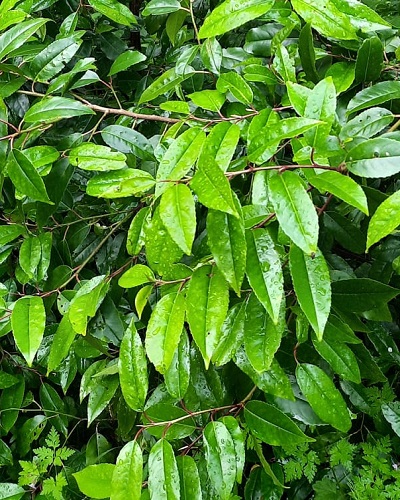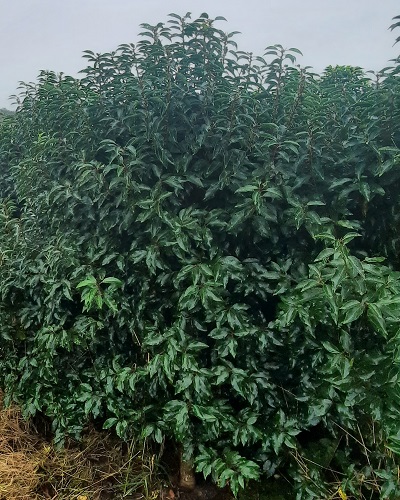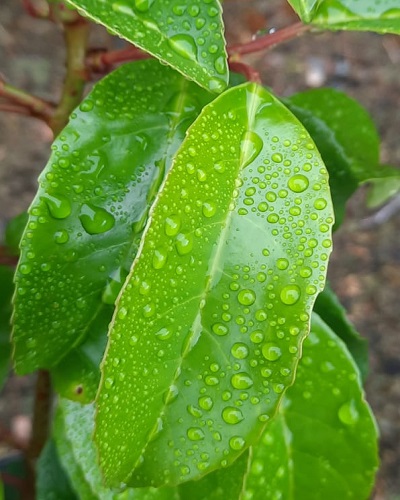
Portuguese Laurel Hedging
PORTUGUESE LAUREL HEDGING
Portuguese Laurel Hedging – Prunus lusitanica hedging is more tolerant to chalk soils and has a smaller leaf size than Cherry Laurel. It is sometimes recognised by its red leaf stalks. We grow and sell two different types of Portuguese Laurel Hedging here in Hyland’s Nursery
Prunus lusitanica : This is fast growing and is compact in width but will easily reach 8 feet in a few years. The stems are not very red. Prunus lusitanica Angustifolia: This is not as fast growing as the more common Portuguese Laurel Hedging but is more bushy in habit and has lovely red stems.
Prunus lusitanica azorica “Tico” – Portuguese Laurel A variety of Portuguese Laurel that provides a lovely dense bushy evergreen hedge or a standalone shrub or tree. The young leaves appear with a tinge of salmon/pink on red/bronze stems and mature to a light green colour. Foliage grows from ground level. Very hardy plant but likes good sun and can tolerate some drought. Height: 2.5m x Spread: 1.5m




Hyland’s nursery Price List for Portuguese Laurel Hedging
Prices listed above are for collection from Hyland’s Nursery in Oulart. For more information please visit our terms & conditions page.
Ways to buy Portuguese Laurel Hedging in Hyland’s Nursery
There are two different ways you can buy our Portuguese Laurel Hedging
Pots or containers:
Portuguese Laurel in pots can be planted all year round and can be any size, from a plant in a 9cm pot to a plant in a very large tub. Their root is settled into the pot and the plant has been actively growing in the pot thus it is well established. A plant in a pot can be sown all year round. As it is established in the pot, there is little disturbance to the plant when planted into the ground so it is more likely to grow. It is seldom that a plant in a pot fails unless the watering conditions haven’t been correct. It will need to be watered in well when initially planted. If planted during a hot time or in the summer, it may need to be watered a few times a week until they get established in the ground.
Root balled:
Root balled plants are larger plants that come in a root wrap of hessian. You leave this hessian on when planting. You only plant these plants when the plant is dormant or has stopped growing for the winter. They are planted from October/November to April/May depending on what the season is like i.e. if the spring is early or not, or if the autumn is very dry.
We don’t sell Portuguese Laurel bare rooted at the moment as we feel they are better coming from a pot or root wrapped as there more likely to grow into a stronger plant and less chance of the plant dying.
Planting Tips
Distance apart:
Smaller plants should be planted at a distance of 50cm apart in a single row. Larger plants won’t need to be planted as close, but how close will depend on how soon you want your hedge to look full.
Preparation before planting:
The ground should be clean and free from weeds and grass. This gives the new plants a good chance to get established. If the area you are going to plant them in has grass or weeds, the ground should be sprayed off a week or so before planting to avoid any competition. To help prevent too many weeds appearing after you have planted your Portuguese laurel hedge, I find it a good idea to put your grass clippings and mulch around the plants as this smothers out the weeds and helps prevent the plants drying out.
Depth:
The plants should be planted deep enough to cover the roots. They do not like to be planted too deep as this may kill them or stunt their growth.
Portuguese laurel hedging doesn’t like to be lying in water so if the area you want to plant them in is wet, you may need to consider draining the ground or making a mound/ditch of top soil on top of the ground and plant them above ground into this topsoil.
Portuguese laurel hedging can grow well in full sun and in shade.
Aftercare:
Once the Portuguese laurel hedge is established you can trim it once a year around mid to late summer. It shouldn’t be trimmed if the weather is really hot and dry. You can give your Portuguese hedge a feed of any high nitrogen feed (eg. in the nursery we use 18-6-12) or poultry manure pellets in late spring/early summer.
General Problems with Portuguese Laurel Hedging
Yellow leaves:
When the leaves turn yellow and fall off this may be caused by lack of water or too much water.
Lack of water (drought):
If you have a newly planted hedge that is turning yellow and is losing its leaves, it is generally not getting enough water. It should not be let get too dry in the first year. If planted in a dry time you will need to water it in well and water it a few times a week- weather dependant.
Too much water (waterlogged):
If you have a more established Portuguese Laurel Hedge and it starts turning yellow, the ground may be waterlogged. Laurel doesn’t like sitting in water for a long period of time.
Stress:
If you have planted large root balled hedging, if your water conditions are correct, it may be the plant reacting to its change of environment and is under a little stress, but once it gets going it should be ok.
Hunger:
Another reason for your leaves turning yellow is hunger and your Portuguese Laurel Hedge may need a granule or liquid feed with high nitrogen or some poultry manure pellets.
Shot hole
Laurel at times suffers with shot hole, where the leaves have holes in them. This usually affects plants under pressure, but generally grows out with time, without any treatment but feeding and watering can help the plant to recover faster.
If you have any questions about Portuguese Laurel Hedging, please do reach out to us by phone +353 87 277 3492 or email for answers.









